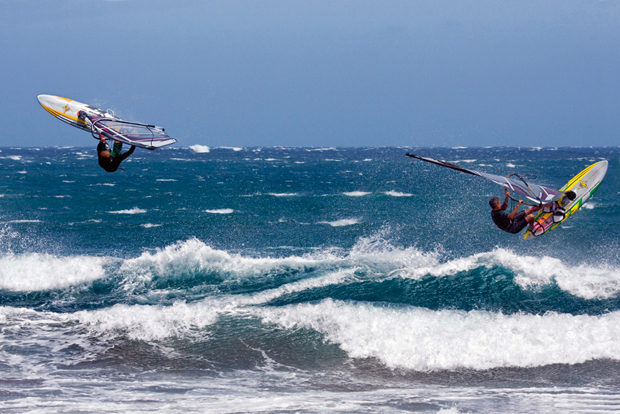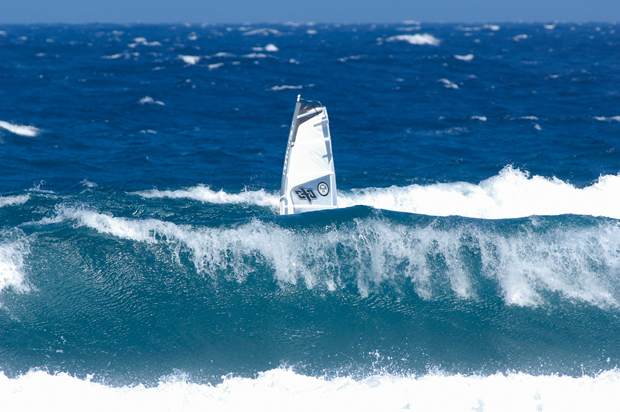
Since being shaken out of their cosy stability some years ago by the arrival of the Starboard Evo, waveboards have been the most ‘happening’ sector of the board market. To see where they’ve got to now, the BOARDS Test Team put 16 of the latest designs through their paces. Pix by Jon Harvey…
Waveboards have changed a lot in the past few years. The biggest positive factor is that they are much easier and much better at waveriding than they ever used to be – and they’re still getting better. The possibilities for riding smaller waves in onshore conditions has been completely opened up to a less skilful level of sailor. The new lower vee / concave underwater shapes along with the extra width and shorter lengths all come together to give an even less governed and more fluent ride in any conditions. At any wave venue you will now see more sailors attempting to sail frontside, and that’s great news. There are down sides though – waveboards generally aren’t quite as suitable for jumping or as easy to take upwind as they used to be, and far fewer of the current designs can fill the very important role of high wind blaster / control board. Which means that ensuring you’re getting the right waveboard for your requirements is more important than ever before. This test will tell you how.
So let’s start by looking at the ways in which waveboards have been changing.There are four trends (all inter-related) which seem to define where waveboard design is going: width, length, underwater shape (concaves etc), and the relation between rocker and volume.
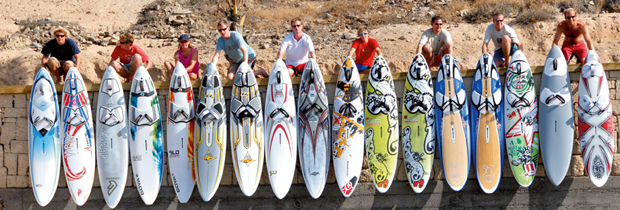
WIDTH:
In the Trads & Stubbies box we discuss planshapes and how they are now converging and stabilising, resulting in two general approaches to board shapes – the trads (longer) and the stubbies (shorter and wider in tail / nose). In general, waveboard widths stopped increasing significantly a couple of years ago. Over the three years prior to that, the width of a waveboard that might be considered sensible for 4.0-5.3m for an average weight sailor (c. 73-78L) had increased by about 2cm. It may not seem much when you consider that the width of a large freeride has increased by about 10-15cm since ‘widestyle’ became the vogue, but it is still very significant for boards used in strong winds. Wider waveboards mean more board directly under the sailor providing lift and stability, and the resulting shorter, wider planing area is less directional with all the benefits and drawbacks that entails. This is now true to a lesser or greater extent of pretty much every modern waveboard, whether stubby or trad. So if you haven’t updated for three or four years you will almost certainly notice a considerable difference. If you have updated more recently, then the width won’t seem significantly different. Other aspects of the latest designs may well, though…
LENGTH:
One very significant factor making it possible to increase width has been the reduction in length and consequent loss of bulk and windage where it isn’t really needed. In ’04 the average length of the test boards was 244cm. It’s now 230.5cm! And, whereas the increase in width has been largely a bonus but with sacrifices in some areas, the reduction in length has been ‘win-win’ for all competent wavesailors. Our test of two years ago saw the biggest differential in lengths, with some brands lagging behind with very long shapes, and others leaping ahead with extremely short ones. Then there was a variation of 34cm in our waveboard test! Simply massive. Since then the shortest lengths have crept back up from 211 to 222 (thank goodness – they were definitely too short) and the longest have continued to shorten from 245 to 236 (which we are also very pleased about). So the range on test here is about 14cm. This probably won’t now change much as these lengths are about right, and both extremes do offer something useful. The benefits of going short are fairly obvious, making boards feel more manoeuvrable but there is a pay-off in making them less easy to get tracking. This is most noticeable when a board is either off the plane or just coming off or onto the plane, when a short board can easily get stuck between waves or chop and trip or catch.
UNDERWATER SHAPE:
The trend started last season, and now by far the majority of boards have either very low vee or single concave underwater shapes. Exactly how concaves and vee affect performance is a highly complicated subject, and we don’t have the space here to do more than scratch the surface. In basic terms, less vee (and this includes single concave) makes boards less grippy, less directionally stable and more pivotal and slidey. The advantage for waveriding is that boards with low vee cut a sharper, cleaner arc through the second half of the bottom turn, are more redirectable throughout the turn and more pivotal off the top. Also, in lower speed rides, they are more likely to turn without stalling. Thus low vee is by and large very good for frontside riding (although sometimes you will find the board losing grip when you wanted to keep it). So it is a fair generalisation to say that boards with lower vee are usually better riding boards in most conditions and that this very much ties in with the big improvement in and much greater specialisation towards riding performance of modern waveboards.
In this test five boards have full single concave (or inverted vee), a further seven either have low vee or else a combination of vee and concave through the tail half. Only four have what might be considered conventional waveboard vee profiles. On the flip side of the coin, low vee boards tend to be noticeably skatier, need more skill to bear away and hold on line when accelerating out through the break, aren’t as easy or quick to push upwind and aren’t as reliable for sudden carved changes of direction (as when heading into jump take-offs). However, it’s a complex issue – some concave boards (e.g.Witchcraft) still offer relatively high grip, while we’ve come across plenty of boards that have vee yet still offer relatively low grip (including the Tabou Pocket Wave from this test), so we are talking generalisations. Plus, of course, the aforementioned drawbacks are not all just down to the reduced vee; the shorter, wider aspect planing surface of modern boards has a very similar effect. But vee is definitely a factor, and if you’re changing from a board with conventional higher levels of vee to a low or single concave shape you will notice quite a difference, and you’ll need to adjust your technique accordingly.
ROCKER, LIFT AND USEFUL VOLUME:
The increase in width through the tail and reduction of area in the nose has the beneficial effect of increasing useful volume. Boards are now bigger underfoot, feel more floaty and consequently generate a bit more lift when moving (although they will still sink just as quickly in no wind at all).
Creating a more floaty-feeling board isn’t high on the list of waveboard designers’ priorities though. Most have taken the opportunity provided by the increased width to significantly increase the rocker through the tail area. As a result, modern boards now tend to feel bigger with more lift, yet are slower and more manoeuvrable than before! Indeed, boards like the Evos, JP Real World Wave and Tabou Pocket Wave have really upped the stakes in the high lift, high rocker ratios. They are easy to sail because they give the sailor so much support and once going they will stay planing at quite low speeds. However, they have more drag once going, which means they need more power from the rig and have less momentum.Yet with the push of even quite a small wave behind them the lift and volume of these boards means that they keep going well regardless of the higher rocker, which then becomes very useful for manoeuvrability. This makes these boards excellent onshore riders, and good high wind freestyle boards as well. However, they can be less suitable for charging around the break when not riding – feeling a bit like sailing a saucer compared to a more conventional waveboard – and they can have a tendency to feel a bit sticky in light winds and/or a bit bouncy in strong.
We are exaggerating the findings slightly to make a point here, but there is definitely an element of this increasing rocker in the majority of boards on test here and the effects, both beneficial and otherwise, are clearly noticeable.
TRADS & STUBBIES
The first generations of shorter, wider waveboards (epitomised by the Evo) opened the way for ‘widestyle’ to infiltrate the wave market and when they first appeared they were very different to the existing ‘trad’ designs, leading to a perception of two completely different strands of waveboard. We classified this (then) new breed as ‘onshore riding boards’ (ORBs) because many of them also led the way with the modern ‘low grip’ hull shapes that further optimised boards for waveriding, particularly at the slower boardspeeds typical of onshore riding, where pivotal manoeuvrability is king. However, in the following years we also started seeing shorter, wider boards that were really good at other sorts of riding too, so the ORB label was no longer really valid. Yet there was still a distinct split between these lower-grip designs and the longer, slimmer ‘traditional’ boards, so we simply referred to them as new-generation waveboards.
Since then, things have changed a lot and the definitions have blurred yet further. All waveboards have got wider and shorter, to the point that they’re all effectively newgeneration – even the longest boards of today are still far more similar in outline shape to the original Evo than to the trads that preceded them. Furthermore, ‘low grip’ hull shapes are now the norm – waveboards, en masse, have adopted less grippy underwater profiles. Consequently, neither ORB nor new-gen is accurate as a name.
Nevertheless, there is still a useful differentiation to be made between waveboards that are particularly short and perhaps a little wider with significantly wider tails and noses, and those that are slightly longer with narrower tails. It’s only a planshape difference, as within either category you will find every other variation in design. For this reason we will refer to them as ‘stubbies’ and ‘trads’, to make it clear that the term refers only to outline shape. (But to reiterate, there is no real connection between these trads and the trads of yesteryear!) The very obvious stubbies are the Starboard Evos,Tabou PocketWave and JP Real World Wave, but the Exocet X Wave, Goya One Series and Fanatic AllWave are also more stubby than trad in shape. The obvious trads are the QuatroWave and Goya CustomWave, with the Fanatic NewWave, JP Pro Wave, Mistral RD and Naish Pro Wave definitely more trad than stubby. There are other boards though (RRD Wave Cult, Thommen1 Maui Wave and Witchcraft) that resist classification as either, which is also likely to be a growing trend. Chances are that we’ll be looking for yet another way to categorise them soon!
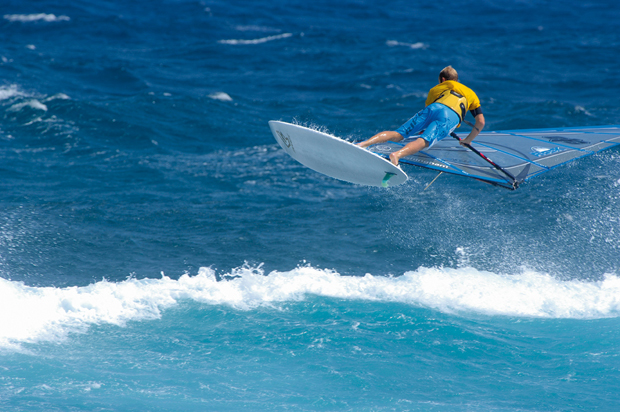
CONCLUSIONS:
Waveboards are now much better for frontside waveriding. We can’t think of a single equivalent board that isn’t now considerably better than it was two or three years ago, or indeed even from last year. All the trends listed above have helped, most specifically with onshore riding, but also for cross-offshore riding too. We are far from certain that the majority of UK wavesailors are taking advantage of this though, as frontside riding is still a difficult discipline. Nevertheless, the improvements are there, and if you want to take advantage of the trends of the moment you should start investing time in your riding skills with immediate effect. It’s great fun, an excellent challenge and can now be performed in most windy conditions at most UK beaches. You no longer need to wait for ‘easy’ cross-offshore winds.
On the other side of the coin, waveboards are now less biassed towards going out. There are still some fine jumping boards available and most modern designs are perfectly good in most conditions to get great jumping, with features like the reduced length helping all boards. However, a considerable number of the modern designs don’t accelerate, hold a line, reach the same speed or carve as instantly as older waveboards. Seeing as jumping is something that most definitely does happen around the UK beaches, this is an area where many people might find that their ‘upgrade’ doesn’t quite bring them the benefits they were expecting. Which is really the predominant finding from this test. Waveboards are now more wave specific than they used to be. Whereas several years ago we might end up recommending waveboards to sailors who rarely if ever see proper waves, we now probably wouldn’t. Waveboards are certainly not such good high wind / control boards nowadays. Shorter rocker flats, less vee, short lengths and greater widths makes them harder to track, more bouncy and pitchy and harder to use generally in strong winds and any chop. Current trends are actually leaving quite a gap in the market, for a longer, narrower, more grippy board to act as a high wind board for non wave specific, intermediate to advanced sailors.
THE BOARDS ON TEST:
Although there were two or three boards on test that would rule themselves out of all but very specific buyers’ shortlists, most of those here will do a pretty good job for the right weight and standard of sailor. One point we need to make very forcefully is that all boards these days are modern. When we refer to ‘trads’ these are not throwbacks to a former time, but simply boards with a slightly longer, narrower-tailed planshape – yet they’re as modern in every way as the stubbies they may be compared to. So, with that firmly established, we’re going to use this stubby / trad planshape divide as the easiest way into a basic understanding of the boards on offer here. It’s not the only division, nor is it necessarily the best comparison method for every board here. But we’ve got to start somewhere!
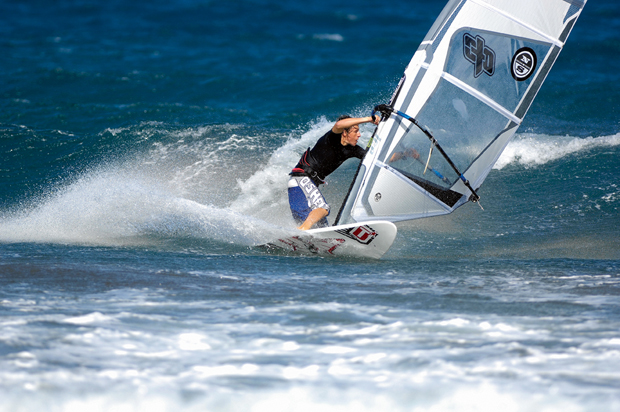
Riding-Biassed Stubbies:
Five boards place themselves clearly in the riding biassed stubby camp, with short lengths, relatively high width in relation to their volume, and high rockers. They must therefore be considered as rivals for a similar market share. They are the two Starboard Evos, the Tabou PocketWave, Fanatic AllWave and JP Real World Wave. Of the four ranges represented the AllWave is probably most different, being a bit smaller, faster and more dynamic. The Evo, with its high float and lift and extremely versatile, easy riding is probably the most accessible for getting into the world of frontside riding, while the Tabou feels shorter, is very nippy and chuckabout but geared to a slightly stronger wind range. The JP Real World Wave is the biggest but least specialised, feeling longer and (though still pivotal) a bit more attached to the water and a bit easier across a range of uses, particularly in less strong winds. We can strongly recommend all of them. We would however equally strongly advise against getting any of them if you don’t intend to devote at least 50% of your wavesailing energies into frontside riding!!!
The Trads:
There is quite a wide spectrum of trad designs. At one end is the Quatro which is quite ‘out there’ in terms of narrow width-to-volume ratio, and high rocker.The Goya Custom might seem as extreme and is certainly small, narrow and highly rockered, but is nevertheless much more recommendable for lighter UK sailors wanting a very nippy and controllable board for high winds.
Next in the trad spectrum comes the JP Pro Wave. Still quite narrow-tailed and highly rockered but a reasonable all-rounder. However, it is definitely optimised for riding faster waves and is very exciting indeed on clean faces. The requirement for reasonable skill, good waves and decent winds will limit its sales potential, if not the pleasure it gives to the right customer.
Then come the Fanatic NewWave and Naish ProWave. Both are quite similar to the JP Pro in the degree of skill needed and the potential rewards, but are a bit faster-rockered and wider-tailed, thus suiting less consistently strong winds and working slightly better in smaller and more onshore conditions. The NewWave was the more popular and is slightly faster and more exciting, but a shade more hectic. All these boards so far have a slight riding bias though all work fine as all-round waveboards.
Like the Naish and NewWave the Mistral Red Dot (RD) is mildly trad in planshape. However, it has quite a different feel to those two boards, due to its flatter rocker and the extra grip from its tail. It is noticeably easier to sail and, though perhaps lacking some of the speed or liveliness of the others, it has a very impressive useable wind range and is very versatile for all aspects of wavesailing.
Faster Stubbies:
Two boards feature a planshape that owes more to the stubby model than trad but are quite different to the high rocker, low grip tendencies of the other stubbies. These are the Exocet X Wave and Goya One. Despite sharing a similar planshape they are really chalk and cheese. The Exocet is dynamic and exacting. Fast, exciting and a great little jump board that takes a bit of skill to handle in tricky waveriding conditions. The Goya is bigger and all ease and accessibility. Quick and easy to get planing but controlled. Easy to ride, though biassed towards moderate, slower conditions. It seems like a stubby planshape designed for medium wind all-round sailing.
Middle Ground Boards:
Our instinctive feeling was that the Thommen1 Maui Wave leans towards the trads and the RRD Cult Wave towards the stubbies, but there is little measurable evidence to support that. They have halfway house planshapes and both feature compromise features in other respects too, such as relatively moderate rockerlines and underwater shapes with moderate vee in evidence. Consequently both are relatively quick and easy to sail, making few technical demands on the sailor and giving a slightly faster, more lively ride than most (yet not to the point of causing complaints about being too big or fast, even in the strongest winds). Both gave us some good riding, with the Thommen possibly taking the honours there and the RRD more favoured for its gybing and appealing ride. Both seemed very well balanced between the needs of the outwardbound jumper and inward-bound rider, which is undoubtedly why both scored very highly in the overall popularity ratings.
TheWitchcraft is another board that refuses to be typecast by the stubby / trad divide. Indeed, there is so much going on elsewhere in the design of this board as to make such divisions meaningless anyway. We won’t try and précis it here as it’s too different to be succinctly compared to the other boards – read the board report for the full story.
EFFECTIVE SIZE
The days of simple good all-round waveboards that suit most people pretty well are largely over. Choosing a waveboard is now all about getting the right style and size for your specific requirements. Choosing a style isn’t all that easy but at least there is information available, from the manufacturers, tests and from the reputation of models that have been around for awhile, albeit updated. Choosing the right size is just as important, but can be quite a lot harder.This is because the required information is limited and oftenmisleading.We have campaigned hard tohavewidthrecognisedas themostusefulandaccurateof thestandard ‘given’measurements for determining effective size, since it works way better than either length or volume in this sector of themarket.However, not everyone has yet got their heads around the difference between a 54cm and 56cm board, and there is also the further complication that max width on its own is at best a fairly rough guide to effective size. Ideally, you do need to factor length, volume and indeed rocker profile into the equation to get a full understanding of howthe boards relate to each other for size. So in the table on page 60 we have done just that, comparing these four primary factors to help you get an idea as to how the board vary in size, andwhichwill be best suited to your needs.
WIDTH
As said, the width figure works fairly well as an overall indicator of performance, and is certainly hugely better than length or volume in this sector of the market. Width is also extremely relevant to stability, whether at rest or when planing.When sailing at speed it effects grip and directional stability, with narrower boards feeling more ‘attached to the water’. It also helps determine the type of manoeuvrability, with wider boards tending to feel more pivotal and narrower boards having more bite. The boards were chosen for inclusion in this test on the basis of width.The guide parameter was that they should be between 54cm and 56cm. It’s fairly standard for brands to space their waveboard sizes by about 2cm of width – sometimes a bit more, sometimes a bit less.This particular 2cmstep (55cm+/- 1cm) was chosen because we consider it about the right width to provide an average weight sailor (70-83kg) with a ‘one waveboard’ option. It’s a size that might be considered an all-rounder, in the sense that it’s usually pretty happy with sails fromabout 4.0 to 5.3m. Unfortunately (from a point of view of pure testing purposes), we ended up with a spread more like 1.5cm each side of our 55cm datum; a width range from 53.5cm to 56.8cm. This spread of 3cm is actually considerably more than simply one ‘size’ up or down. In fact, the widest (Goya One 77) is happy carrying up to 5.5m and could be considered as an all-round waveboard for sailors of up to 90kg, whereas the narrowest (Goya Custom75) is only really happy carrying up to 5.0m and should only really be considered as an all-round waveboard for sailors below about 72kg. That’s some difference. And yet these widest and narrowest boards are only split by a mere 2L of quoted volume! This highlights the problem of volume as a determiner of size. It doesn’t work, for two reasons.The first is that the thickness of the hull (which is what determines volume when width and length have been taken out of the equation) has quite a limited effect on effective size. The second is that volume is non-verifiable and simply can’t be trusted. We are fairly sure, for example, that the above two boards are actually separated by significantly more than just 2L of volume. It would certainly appear so, and it just shows that if there is inconsistency between boards from one manufacturer, there is almost certainly more between rival brands! In the days before stubbies and trads,maxwidthwas amore useful measurement because planshapes were very similar. These days things have changed and a stubby can easily be a couple of cm or more wider in the tail than a trad shape of equivalent max width, thus giving it quite an increase in planing area and lift. Thus, even though the boardswere chosen due to their apparent similarity ofwidth there can still be quite a difference between them. In our view the single prime measurement (if itwere possible tomeasure it) for describing a board’s size would be the area of approximate planing flat. Unfortunately, it’s impossible to measure, being an amalgamation of a variable width curve and variable rockerline. Max width usually gives a passable guide to this but actually better would be a figure that described the widthof theplaningarea (the average width between the tail andabout a metre forward).The width of the planing area is chiefly useful because (together with the rocker line) it’s instrumental in determining the lift generated, and lift more than any other feature makes a board feel either big or small when planing.Too much and a board feels bouncy and uncontrollable, too little and you either aren’t planing or at least not fast or reliably enough to carry out the jumps and rides that you want.
. In the Effective Size table, to take into account the factors mentioned above we have tried to give a more immediate comparison of planing width by looking at the planing middle-width of each board; the average of the tail width and max planing width (i.e. adding together the tail width – 30cm from tail – and max planing width of each board and dividing by two).You may think that a few mm either way doesn’t make much difference, but just 5mm is enough to make a noticeable difference between boards.We then show this as + or – compared to amedian figure, representing what is typically thought of as a 75L board (and pretty close to the middle of the spectrum of boards on test here).
ROCKER
Rocker is exceptionally complex, as it’s both infinitely variable and has lesser, greater or just different effects depending on where it is along the length of the board.The bit that chiefly concerns us as relevant to effective board size is the bit that spendsmost of its time in the water – i.e. the back half. The difference between otherwise similar boards with either high rocker through the tail ormoderate rocker ismassive. Anyone would notice it almost immediately upon changing boards. High rocker requires much more power before the board will plane and needs continually more rig power to keep planing. However, it makes a board feel more manoeuvrable and happy to turn no matter how strong the wind is, and can assist control.All these characteristics make a board effectively smaller, and the opposite is true with flatter rocker making a board feel bigger.This is because there’s more of it presented to the water, creating more lift at any given wind strength. In the table: We measure rocker through the tail by balancing a straight edge on the bottom of an upturned board, at a point between the straps.We end up with a distance between the straight edge and tail that we call tail rocker, and we also measure how far fromthe tail it is before the board has risen to be 2cmaway fromthe straight edge going towards the nose.The effect of these two figures can be subtly different but ultimately if either of them show high rocker (lots of tail rocker or a very far back – sub 135cm– 2cmpoint), it will be clearly apparent in the board’s performance. Indeed, if both of them show high rocker it is likely to be extremely significant, and vice versa. Generally the ‘smallening’ (slowing, controlling and manoeuvring) effect of rocker is greater the closer it is to the tail. These figures can all be viewed in the main measurements table. Unfortunately, despite repeated attempts we have not been able to come up with a single index figure that gives an accurate portrayal of the overall rocker (particularly as other factors such as vee and concave will also provide a degree of error in any measurement of rockerlines). However, when measuring and comparing the rocker profiles of the boards it is fairly easy to make an overall qualitative comparison, which is what we have done here in the table, again basing our ratings around the ‘average’ board profile (which is in itself actually quite heavily rockered compared to previous generations of waveboards, or indeed any modern bigger board. A ‘low’ rating here would still be very high for an 85L freestyle-wave board, for example).
VOLUME
Most waveboards don’t float their riders anyway in zero wind, so a few litres more or less volume will rarely make the difference between a board that can or can’t be sailed off the plane.There will always be a degree of difficultywhen slogging (sailing off the plane). Nevertheless, volume (when its measurement can be trusted) is useful in helping to gauge howeasy sloggingwill be. It is also relevant in determining how easily a board will ‘unstick’ before planing. Even fast-rockered boards that plane very easily if ‘worked’ (borne away and pumped)will tend to sit lowin thewater and resist initially if their volume ismuch below the weight in kgs of the rider.Volume also has a bearing on howmuchweight is needed to depress a rail.The thicker boardwill have a greater tendency to bounce out of a turn, but also be less likely to catch a rail and trip or stall at low speeds. Volume is therefore certainly relevant and should be considered as one part of determining size. (But as stated, it’s unfortunate that it so often gets used as the accepted classifying measurement. There are many examples in this test where it can be extremelymisleading.) In the table:To try and make it less misleading we have listed the quoted volumes in the table but have added +/-/= to indicate whether the quoted volume felt more, less or roughly correct in relation to the figures of the other boards on test.
LENGTH
We are now a far cry from the days when length was the crucial measurement, but it still has importance and it varies quite a lot – with significant effects. These days the size effect of length is not really about a conventional understanding of board size, but more about the effect of extra manoeuvrability (as you go shorter) paying off against awkwardness of use. In particular, the heavier you are, the more awkward you will find a very short board and the less you will appreciate its extra manoeuvrability, so there is still a relationship between length and effective size. In the table:The figure shows the difference between the board’s length and our typical average of 230.5cm (i.e. -5 means the board actually measures 225.5cm). Our measured length of the boards usually don’t tally with manufacturers’ measurements since we measure fromnose to tail and they tend tomeasure round the rocker. Boards belowabout 226/7cmcan feel a bit edgy and tend to introduce a little extra difficulty for the averageweight sailor.Those above about 233 now start to feel slightly longer than the average (ironic, isn’t it?)
USING THE TABLE
Start with the PlaningWidth Index. This should constitute your basic framework of understanding the size of a board. Remember that the index is in relation to an ‘average 75L board’. 1cmup or down should be considered as a potentially useful step in size. 2cmwould be a complete ‘board size’ or possibly more.You can then adjust your thinking about its size depending on the other values, and how important they will be to you.The lower the rocker rating, the bigger the boardwill feel. We would suggest weighting rocker slightly higher than length or volume, with a lower rocker rating making the board effectively ‘bigger’. Thus, although the JP Real World Wave has the widest index figure, its higher rocker makes it effectively a somewhat ‘smaller’ board (suited to a stronger wind range) than the Goya One which is a bit narrower but with a much flatter rocker. Length is scarcely relevant to size if you’re a skilled sailor buying a board with a litreage above or around your weight in kg, but is much more relevant if you’re buying small. Volume on the other hand is almost more important if you’re buying a bigger (lighter wind) board that you will be expecting to spend time on slogging.
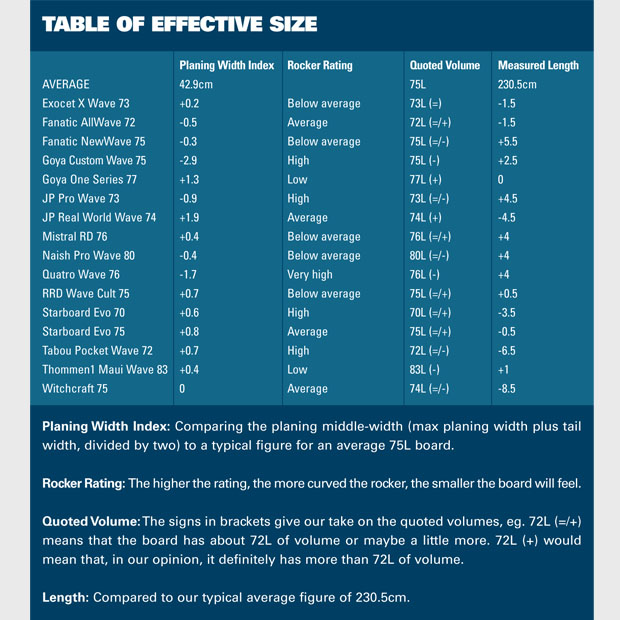
The Popular Choices
We hesitate to do this because the sample of sailors who tried the boards is small and the boards are so varied. One man’s feast will surely be another man’s famine. However, some boards were, on balance, more popular than others so it seems fair to point them out. Here are the five most popular with the guesters and testers, in no particular order.
Goya One Series: So relevant to so many sailors and conditions, and so easy and just good fun to use.
Witchcraft:This is not a recommendation to everyone to rush out and buy one; more a recognition of an extremely innovative and experimental approach to design that is certainly coming up with exciting results. You may love it, but there is definitely a Marmite element about it.
RRD CultWave:We hesitate to use the word all-rounder but so often RRD seem to come up with the sort of design that is geared to please as many people as possible – with a bit of added panache and Italian style thrown in! JP RealWorldWave: Not the most radical or exciting of the high-rocker, riding-biassed stubbies but the one that crept highest up the popularity lists due to its range and ease.
Mistral RD: Does everything well, liked by just about everybody, grows on you quietly. It’s probably fair to say that – other than theWitchcraft, which stood out due to its sheer wow factor – the common ground between the other four is their versatility. This test was carried out in a wide range of windstrengths and sea conditions, and it’s amazing how quickly it becomes obvious which boards have the wider range and user-friendliness. Nevertheless, many of the other boards turned up at the top of individual favourite’s lists for other reasons. The Exocet X Wave scored top three for several guesters, the Thommen1 MauiWave was a winner for one guester and two testers… The Fanatic AllWave, Starboard Evos, Fanatic NewWave and Tabou PocketWave all had their supporters too and any one of them could have made it higher on the overall list had different sailors been choosing.
Which all clearly illustrates that the majority of waveboards are now less allround, and as such tend to appeal more distinctly to specific sorts of buyer. So don’t just rush out and buy the prettiest one – make sure you do get the right one for you.
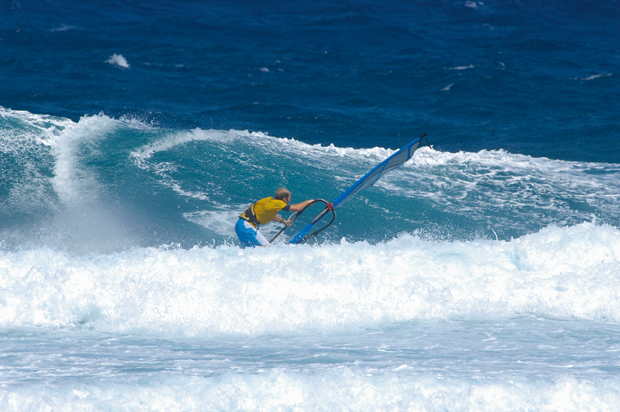
ABOUT THE TEST:
This test was carried out over two weeks in August, in the reliable summer winds of El Médano inTenerife, based at the excellent OTC.The regular team of Ian Leonard, Emile Kott and Ed Frisby plus four guest testers (Mungo Sheppard, Mary Chapman, Tom Blakely and Harry Davidson) enjoyed a wide variety of wave conditions from waist-high to overhead, and every useable windstrength from maxed 4.0m through to comfortable 5.3m sailing. Our grateful thanks to OTC (www.otc-windsurf.com), and their superb staff who were always on hand to assist with our frequent kit changes. Nearly all the boards tested here are available in the OTC line-up for you to do your own testing – and it’s a great testing venue! Check out their website or contact Sportif (www.sportif-uk.com) for details on OTC holidays. We can also highly recommend contacting Pauline Martinez for El Médano accommodation, she has a great line-up of villas and apartments in town. (www.martinez.ch, [email protected]). Our pix were taken by local snapper Jon Harvey (www.jonharvey.org), who also specialises in surfing photography and knows the breaks of the island like the back of his hand.

